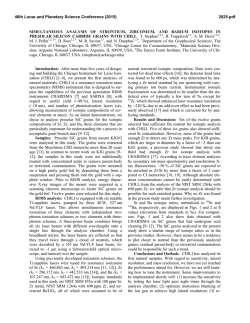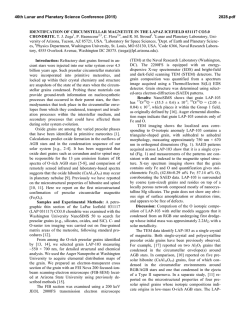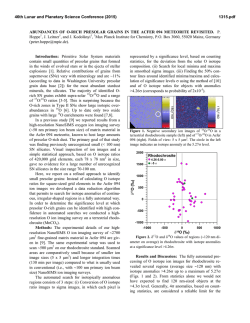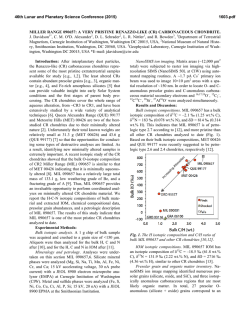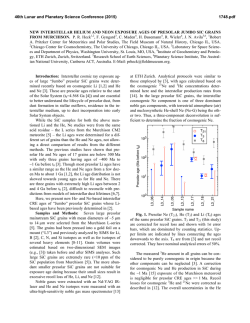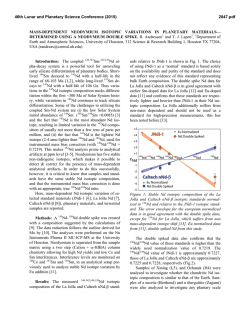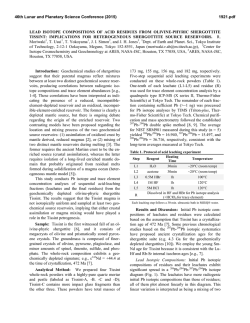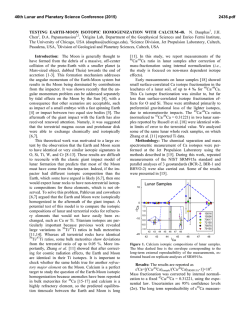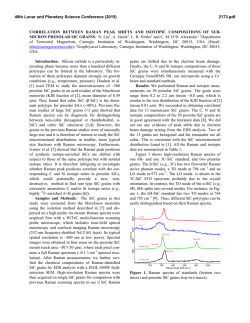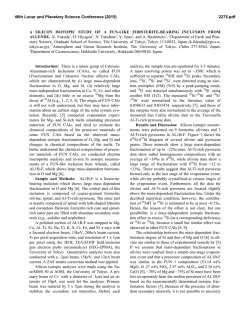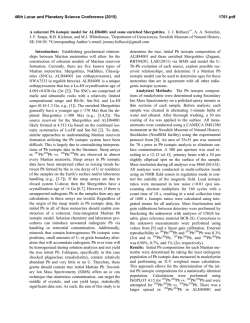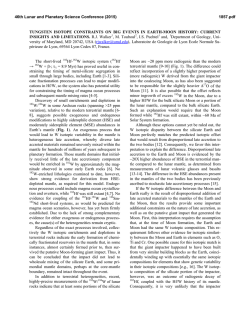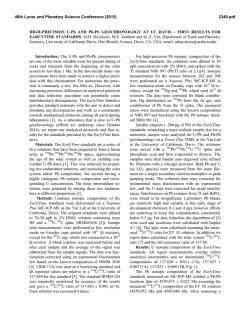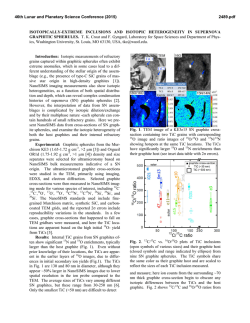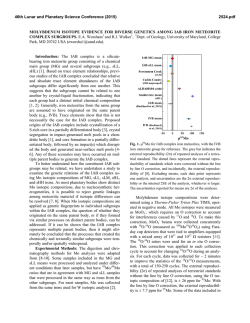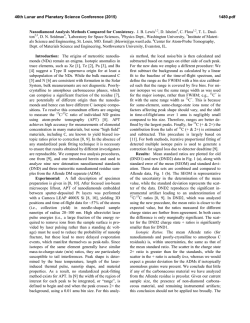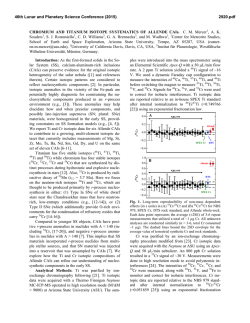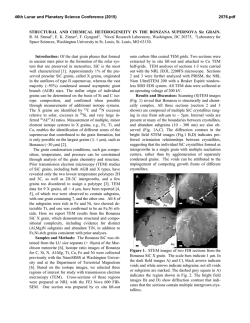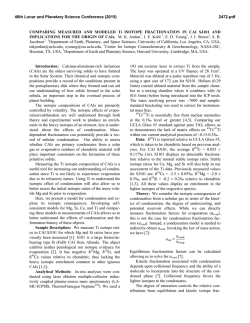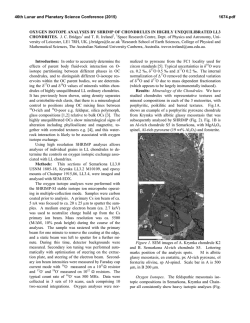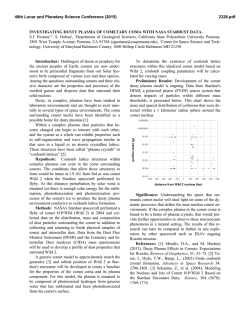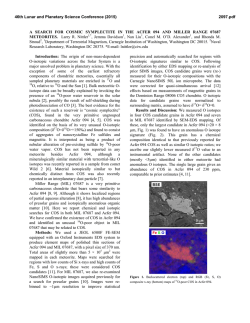
Presolar Materials in a Giant Cluster IDP of - USRA
46th Lunar and Planetary Science Conference (2015) 2603.pdf PRESOLAR MATERIALS IN A GIANT CLUSTER IDP OF PROBABLE COMETARY ORIGIN. S. Messenger1, D. E. Brownlee2, D. J. Joswiak2, and A. N. Nguyen3 1Robert M Walker Laboratory for Space Science, EISD, ARES, NASA Johnson Space Center, Houston TX scott.r.messenger@nasa., 2University of Washington, Dept. of Astronomy, Seattle WA, 3Jacobs, NASA Johnson Space Center, Houston TX. Introduction: Chondritic porous interplanetary dust particles (CP-IDPs) have been linked to comets by their fragile structure, primitive mineralogy, dynamics, and abundant interstellar materials [1]. But differences have emerged between ‘cometary’ CP-IDPs and comet 81P/Wild 2 Stardust Mission samples. Particles resembling Ca-Al-rich inclusions (CAIs), chondrules, and amoeboid olivine aggregates (AOAs) in Wild 2 samples are rare in CP-IDPs [2-5]. Unlike IDPs, presolar materials are scarce in Wild 2 samples [6]. These differences may be due to selection effects, such as destruction of fine grained (presolar) components during the 6 km/s aerogel impact collection of Wild 2 samples [7]. Large refractory grains observed in Wild 2 samples are also unlikely to be found in most (<30 m) IDPs. Presolar materials provide a measure of primitiveness of meteorites and IDPs. Organic matter in IDPs and chondrites shows H and N isotopic anomalies attributed to low-T interstellar or protosolar disk chemistry [8], where the largest anomalies occur in the most primitive samples. Presolar silicates are abundant in meteorites with low levels of aqueous alteration (Acfer 094 ~200 ppm) and scarce in altered chondrites (e.g. Semarkona ~20 ppm) [9]. Presolar silicates in minimally altered CP-IDPs range from ~400 ppm [2] to 15,000 ppm [10-12], possibly reflecting variable levels of destruction in the solar nebula [13] or statistical variations due to small sample sizes. Here we present preliminary isotopic and mineralogical studies of a very large CP-IDP. The goals of this study are to more accurately determine the abundances of presolar components of CP-IDP material for comparison with comet Wild 2 samples and meteorites. The large mass of this IDP presents a unique opportunity to accurately determine the abundance of presolar grains in a likely cometary sample. Sample description: The Giant Cluster IDP U220GCA (Fig. 1) is a very large anhydrous chondritic porous particle that disaggregated when it impacted its oil-coated stratospheric collection plate at 200 m/s. The core of the impact is a dense monolayer of thousands of dark and transparent particles, the largest of which is 40 µm long. The 350 m core is surrounded by a lowdensity debris halo 1 mm across. The particle appears to have been a few hundred m fragile aggregate that pancaked to a thin layer of debris. Its extreme fragility is a strong argument for an origin in either a comet or Fig. 1: Transmitted light (L) and dark field reflected (R) light images of U2-20GCA. Scale bar is 0.1 mm. an asteroid whose interior did not experience compaction or other grain-binding processes. Like most CPIDPs it is an unequilibrated aggregate with sub-m and much larger components, a mix of silicates, sulfides and organics as well as notable materials that include En whiskers, LIME (forsterite with high Mn) olivine grains, moderately refractory fragments including Alrich chondrules, AOAs, possible CAI fragments and augite grains with high Cr and Ca [14-16]. Experimental: Sample preparation: Since presolar grains are mostly sub-m, we used a novel sample preparation technique to concentrate sub-m grains for isotopic measurements. We produced a dense mount of sub-m grains that could be microtomed for coordinated NanoSIMS isotopic and TEM mineralogical study. Using a needle, we placed fines from the particle on a glass surface along with the high viscosity silicone oil that they were collected on. Gentle separation of fines was done by sweeping back and forth with the 5µm tip of a glass needle and “gentle grinding” with an acrylic plate. The acrylic is weaker than solid IDP components and does not fracture phases such as olivine or sulfide. The silicone oil was removed by a hexane wash. We developed a “rubber stamp” method to concentrate grains onto a plane that could be microtomed. A 50 µm square mesa of silicone rubber was used to repeatedly pick-up and concentrate samples. Care was taken to keep the mesa as planar as possible. Particle pickup was done with great control by mounting the glass or acrylic slide with the particle side down and then bending the slide down as it was viewed in a stereo microscope, looking through the slide. When a sufficient number of particles was collected on the mesa (Fig. 2), it was embedded in acrylic and microtomed, resulting in 80 nm-thick microtome slices with a high density of fines. 46th Lunar and Planetary Science Conference (2015) 2603.pdf Fig. 2: Optical microscope image of the U2-20GCA fines concentrated on the mesa. Scale bar is 10 m. NanoSIMS: Isotopic measurements of Au-mounted microtome sections were performed with the JSC NanoSIMS 50L ion microprobe. O and N isotopic imaging was performed simultaneously, with 16O-, 17O-, 18O-, 12 14 - 12 15 C N , C N , and 28Si- images acquired using electron multipliers. Images were obtained by rastering a 1 pA, <100 nm Cs+ beam over 15-20 m fields of view. Images were repeatedly acquired for a total of 30 – 60 image layers in each analysis. Sample charging was mitigated with the use of an electron flood gun. O and N isotopic images were acquired from 10 m grains of San Carlos olivine and 1-hydroxy benzotriazole hydrate (respectively) as external isotopic standards. Results & Discussion: We obtained isotopic images of a total of ~100 m2 of O- and CN-rich grains over 7 imaged areas. O and N isotopic compositions were determined for subgrains >0.1 m in size. N isotopic images showed 1-3 m concentrations of carbonaceous material having 15N values ranging from ~ 0 ‰ to 1,500 ‰. Unlike the case with other CP-IDPs, the carbonaceous material was largely separated from the mineral grains, probably due to the sample processing. O isotopic ratios of all but one of the >200 O-rich subgrains measured fall within the range of Solar System materials. One 500 nm silicate grain had anomalous O isotopic compositions indicative of an origin from an evolved star. The O isotopic composition (17O = -227±31 ‰, 18O = -102±15 ‰, 1) suggests an origin from a low metallicity red giant star or a supernova (Fig. 3) [17]. The identification as a silicate is based upon the measured 28Si/16O ratio. If this grain is present in adjacent microtome TEM sections, a detailed mineralogical study will be possible, followed by isotopic measurements of additional elements to better constrain the stellar source. Based upon the total area imaged and the size of this grain we estimate a presolar silicate abundance of 2,500 ppm among the finegrained component in this sample. This compares well Fig. 3: O isotopic distribution of presolar silicates & oxides and the grain identified here (red star) [18]. with the estimated pre-collection impact abundance in Wild 2 samples of 600-830 ppm [7]. The large N isotope anomalies and preliminary high presolar silicate abundance of U2-20GCA are in line with the most primitive CP-IDPs. This supports an origin from a very primitive parent body, possibly a comet. U2-20GCA is a close mineralogical analog to comet Wild 2 samples. As reported in this conference by Pepin et al., U2-20GCA shows similarities to Wild 2 samples in the dispersion of Mn and Cr contents of ferrous olivines and noble gas composition. U220GCA contains a representative sampling of large refractory materials, fines, presolar grains, and organic matter. Akin to Wild 2 samples, it represents a significant “sample return” from its parent body. References: [1] Messenger S. et al. (2014) in: Dust in the Solar System: Properties and Origins. [2] Joswiak D. J. (2014) GCA 144, 277. [3] NakamuraMessenger K. et al. (2011) Met. Planet. Sci. 46, 1033. [4] Matzel J. E. P. et al. (2010) Science 328, 483. [5] Nakamura T. et al. (2008) Science 321, 1664. [6] McKeegan K. D. et al. (2006) Science 314, 1724. [7] Floss C. et al. (2013) ApJ 763, 140. [8] Pizzarello S. et al. (2006) in Meteorites and the Early Solar System II. [9] Zinner, E. (2013) in Treatise on Geochemistry, 2nd ed. 1.4:181. [10] Floss, C. et al. (2006) GCA 70, 2371. [11] Messenger S. et al. (2003) Science, 300, 105. [12] Busemann H. et al. (2009) EPSL 288,44. [13] Messenger S. et al. (2007) LPS 38, #2122. [14] Brownlee D. E. et al. (2011) LPS 42, #2235. [15] Joswiak D. J. & Brownlee D. E. (2014) LPS 45, #2282. [16] Joswiak D. J. et al. (2013) LPS 44, #2410. [17] Nittler L. R. et al. (2008) ApJ 682, 1450. [18] Hynes K. M. & Gyngard F. (2009) LPS 40, #1198.
© Copyright 2026
